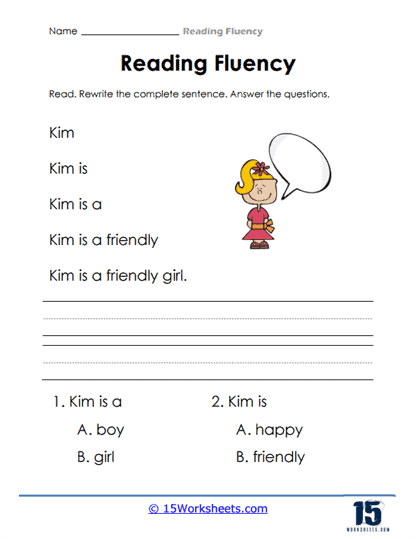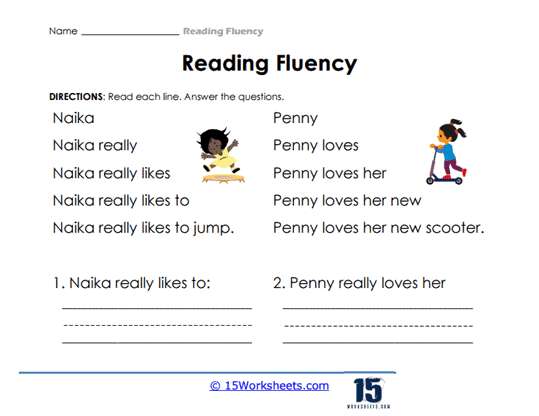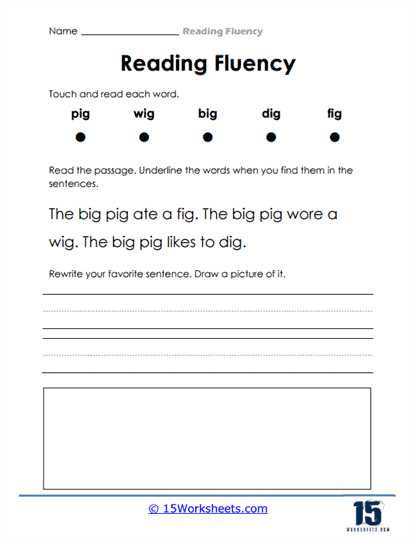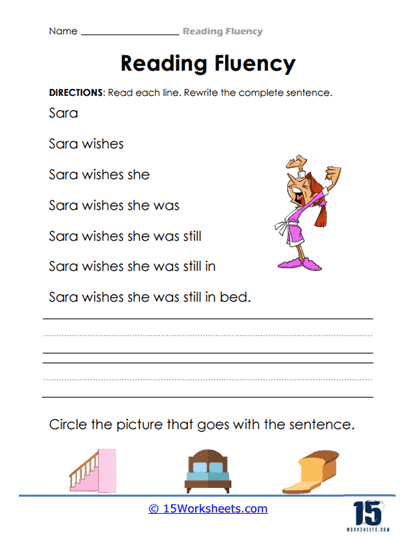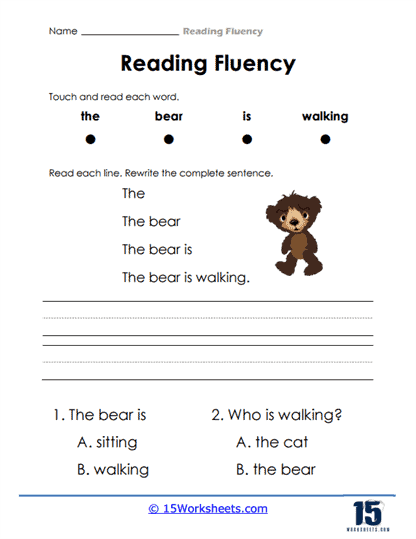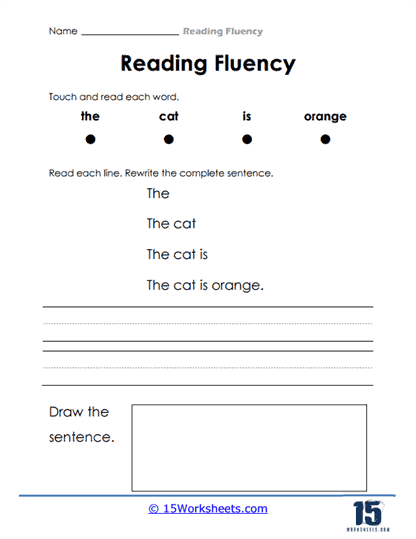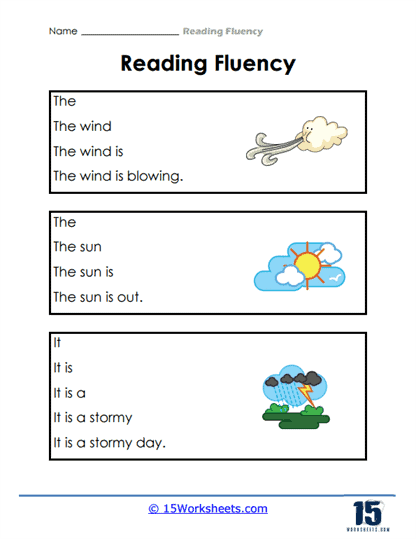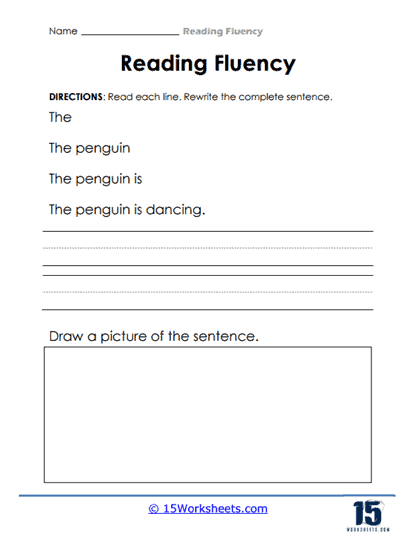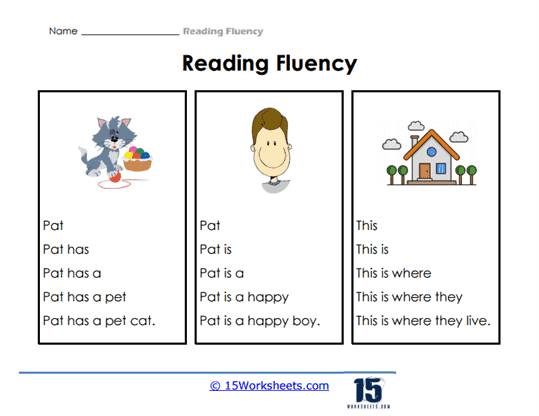Reading Fluency Worksheets
About These 15 Worksheets
Reading fluency worksheets are more than just tools for improving a student’s reading pace. They are a bridge to deeper comprehension, enriched vocabulary, and enhanced overall language skills. These worksheets are designed with a clear purpose: to help students read smoothly, accurately, and with a natural rhythm that reflects an understanding of the text. For students in elementary and middle school, where literacy development is a cornerstone of academic success, these worksheets are invaluable. They offer structured practice that builds foundational skills while also fostering a love for reading.
At the heart of reading fluency is the ability to read a text not just word by word, but in a way that makes sense, allowing students to capture meaning without stumbling over the mechanics of reading. Fluency involves accuracy-reading words correctly; speed-reading at a comfortable, efficient pace; and expression-reading with the appropriate intonation and rhythm that brings the text to life. When students develop fluency, they are better equipped to grasp the content and nuance of what they’re reading because they are no longer bogged down by the need to sound out every word. This shift enables them to focus on the more important task of comprehension-understanding and engaging with the ideas and messages in the text.
The variety of exercises found in these reading fluency worksheets is key to their effectiveness. These exercises range from timed readings, where students practice reading passages within a set amount of time, to repeated reading activities that encourage students to read a text multiple times, improving accuracy and speed with each attempt. Some worksheets incorporate partner reading or choral reading, where students read aloud together, building confidence and expression through shared practice. These exercises are not just about reading faster; they are about developing the reader’s ability to navigate texts with ease and enjoyment, which in turn makes them more confident and capable readers.
Beyond improving reading fluency, these worksheets play a crucial role in language development as a whole. When students work on fluency, they are also indirectly improving their grammar and vocabulary skills. By encountering words in context, they learn how language is structured and how sentences flow together, which reinforces their understanding of syntax and grammar rules. Additionally, encountering new words in fluent reading exercises allows students to expand their vocabulary in a natural, meaningful way, rather than through rote memorization. This dual benefit makes fluency worksheets a multifaceted tool in language arts education.
One of the standout features of reading fluency worksheets is their adaptability. Educators can tailor them to fit the needs of individual students or entire classrooms, ensuring that all learners, regardless of their current reading level, can benefit. Whether a student is struggling with basic reading skills or refining their ability to read with expression, these worksheets can be customized to provide the right level of challenge. This flexibility makes them an essential resource in any classroom, as they can be used to support a wide range of learning objectives-from improving basic literacy skills to enhancing advanced language proficiency.
Types of Exercises On These Worksheets
a. Phonemic Awareness
– These focus on recognizing and manipulating the sounds in words (phonemes).
– Activities may include rhyming, segmenting, and blending sounds.
b. Decoding Practice
– Exercises designed to practice sounding out words.
– Often includes lists of words with common phonetic patterns or sight words.
c. Repetitive Reading
– Reading the same passage multiple times.
– Improves speed and accuracy.
d. Timed Reading
– Students read a passage within a set time frame.
– Helps in increasing reading speed.
e. Expression and Intonation Practice
– Worksheets with passages that encourage students to read with expression.
– May include dialogues or texts with varied emotional tones.
f. Comprehension Questions
– Follow-up questions to ensure understanding of the text.
– Promotes deeper engagement with the material.
g. Vocabulary Worksheets
– Focus on understanding and using new words.
– Often includes definitions, synonyms, antonyms, and usage in sentences.
h. Grammar and Sentence Structure
– Exercises focusing on proper grammar and sentence construction.
– Enhances the understanding of how language works.
i. Paired Reading Exercises
– Students read aloud in pairs.
– Provides immediate feedback and peer learning opportunities.
The Benefits of These Worksheets
Our reading fluency worksheets offer a multitude of benefits, serving as an essential tool in enhancing a student’s reading capabilities. They significantly improve reading accuracy and speed, which are fundamental components of fluency. By practicing with these worksheets, students learn to recognize words more quickly and read them with less hesitation, leading to smoother, more efficient reading. This improvement in fluency directly impacts comprehension; as students spend less effort on decoding each word, they can focus more on understanding the text’s overall meaning. Additionally, these worksheets often incorporate exercises designed to enhance expression and intonation, teaching students to read with the appropriate emotional tone and rhythm, which is crucial for engaging and effective communication.
Beyond the immediate benefits to reading, these worksheets also contribute to broader language development. They often include vocabulary exercises that expand a student’s lexicon, providing context for new words and reinforcing their meanings. Grammar and sentence structure are also commonly addressed, subtly improving students’ writing and speaking skills alongside their reading abilities. Regular practice with these worksheets can also boost a student’s confidence in their reading and language skills, making them more likely to participate in class discussions and other academic activities.
The structured nature of reading fluency worksheets allows for gradual progression, starting from simple texts to more complex ones, enabling students to build their skills systematically. This step-by-step approach ensures that students are not overwhelmed and that they experience a sense of accomplishment as they progress, further motivating them to engage with reading. Moreover, these worksheets can be tailored to individual needs, making them a versatile resource for teachers to address specific areas where a student may require additional practice.
Components of Reading Fluency
Reading fluency is a multi-faceted skill that goes beyond the ability to simply read words aloud. It encompasses various components, each playing a critical role in shaping a reader’s overall ability to understand and engage with the text. By developing fluency, readers not only improve their speed and accuracy but also enhance their comprehension and enjoyment of reading. Let’s explore the essential components of reading fluency and how each contributes to a more seamless, meaningful reading experience.
Accuracy is the cornerstone of reading fluency. At its core, accuracy involves the ability to correctly identify and pronounce words in a text, ensuring that the meaning of the passage is preserved. Fluent readers make very few errors, and when they do, they quickly recognize and self-correct them. Accuracy is vital because even small mistakes can disrupt comprehension and slow down the reading process. Imagine trying to follow a conversation where key words are constantly misheard or misunderstood—this would lead to confusion and a fragmented understanding. Similarly, when readers frequently stumble over words or misinterpret them, it derails their understanding of the text, making it harder to grasp the bigger picture.
Reading rate, or the speed at which a person reads, is another crucial aspect of fluency. A fluent reader maintains an appropriate pace, neither reading too slowly nor too quickly. If reading is too slow, it can interfere with comprehension, as the reader may lose track of earlier ideas by the time they reach the end of a sentence or paragraph. Conversely, reading too quickly can result in skimming over details, missing key elements of the text, or failing to fully absorb the meaning. Finding the right pace is essential, and this often depends on the material and the reader’s purpose. A leisurely pace might be fitting for savoring a novel, while more technical or dense material may require a slower, more deliberate approach. Fluent readers can adjust their rate based on context, making them more adaptable to different types of reading.
Prosody adds the emotional depth to reading. It refers to the expression, intonation, and rhythm with which a reader delivers the text. Fluent readers use prosody to bring the words on the page to life, applying appropriate pauses, stress, and variations in pitch to reflect the meaning and mood of the text. This skill is particularly important when reading aloud, as it helps convey the emotions, characters, and events more vividly. Prosody is not just about sounding expressive; it’s an essential tool for comprehension. When a reader uses expression effectively, it indicates that they understand the nuances and emotions in the text, which deepens their engagement and makes reading more enjoyable for themselves and others.
Phrasing is another critical element of fluency, referring to the ability to group words into meaningful chunks, or phrases, rather than reading each word in isolation. Fluent readers intuitively break text into syntactical and semantic units, allowing them to better understand the relationships between words and ideas. For instance, reading a sentence like “the boy ran quickly to catch the bus” as a smooth, cohesive unit is far more effective than reading each word separately. When readers grasp the structure of sentences and paragraphs, they can navigate the text more fluidly, making sense of complex ideas without becoming bogged down by individual words.
Automaticity is what truly sets fluent readers apart from struggling ones. This is the ability to recognize and decode words instantly, without conscious effort. Over time, as readers build a vast sight vocabulary, they no longer need to pause to sound out or decode familiar words. This automaticity allows the brain to focus on higher-level comprehension tasks rather than being tied up with basic word recognition. It’s like driving a car-when you’re first learning, every maneuver requires full concentration, but with practice, many actions become automatic, freeing you to focus on the road ahead. In reading, automaticity similarly frees up mental resources, allowing readers to dive deeper into the meaning of the text.
Although not always considered a component of fluency, comprehension is undeniably linked to a reader’s fluency. In fact, comprehension is the ultimate goal of fluent reading. Fluent readers can focus their cognitive energy on understanding and interpreting the text rather than expending effort on decoding individual words. A strong foundation in the other components-accuracy, rate, prosody, phrasing, and automaticity-supports better comprehension. When readers can effortlessly navigate a text, they are better equipped to analyze themes, infer meanings, and make connections to other ideas, thus enriching their overall reading experience.
A wide vocabulary is another building block of fluency. Fluent readers have a large reservoir of words at their disposal, which allows them to swiftly recognize and understand words in context. A well-developed vocabulary also helps readers infer the meaning of unfamiliar words using contextual clues, which keeps the flow of reading smooth and uninterrupted. In contrast, a limited vocabulary can slow down reading and hinder comprehension, as readers may frequently stop to look up words or struggle with understanding the text’s meaning.
Background knowledge or prior knowledge is an often-overlooked but essential aspect of reading fluency. Readers who possess a rich base of knowledge in various subjects are better able to make connections between the text and their own experiences or understanding of the world. This ability to relate new information to what they already know enhances comprehension and helps readers interpret complex ideas more quickly. For example, when reading about historical events or scientific concepts, a reader with prior knowledge on the topic can more easily grasp the context and significance of what they are reading.
Improving Reading Fluency Over Time
Improving reading fluency is a gradual process that requires consistent practice and the right strategies. For students, the journey to becoming more fluent readers starts with regular reading practice. By engaging with a variety of texts consistently, students become more familiar with different word patterns and sentence structures, which naturally enhances their ability to read more smoothly and quickly. It’s crucial that this practice is not only frequent but also involves materials that are at the right level of challenge-not too easy but not overly difficult.
Another key strategy is focused practice on specific components of fluency, such as speed, accuracy, and expression. For speed, timed reading exercises can be particularly effective. Students can track how many words they read per minute and aim to gradually increase this rate. To improve accuracy, phonics exercises, which focus on the relationship between letters and sounds, are invaluable. These exercises help students decode new words more efficiently. For expression, reading aloud is a powerful tool. When students read aloud, they practice using the correct intonation and rhythm, which are essential for expressive reading. This also helps them to better understand and enjoy the text, further motivating them to read.
Guided reading sessions, either with a teacher, parent, or peer, can also significantly boost reading fluency. In these sessions, immediate feedback can be given, helping students correct their mistakes in real-time and learn more effectively. These guided sessions are also opportunities to discuss the content, which enhances comprehension, a critical component of fluency.
Incorporating technology can also play a role. There are numerous digital tools and applications designed to improve reading skills, offering interactive and engaging ways for students to practice. These tools often include features like text-to-speech, which can model fluent reading for students, and adjustable text complexity, allowing students to challenge themselves at their own pace.
A positive attitude and supportive environment are crucial. Encouragement from teachers, parents, and peers plays a significant role in motivating students to practice regularly and take on new reading challenges. When students feel supported and confident, they are more likely to engage in reading activities and, consequently, improve their fluency.






